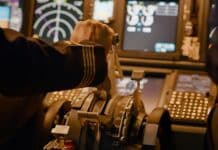For years it was thought that aviation safety was essentially a technical concept: with reliable aircraft and qualified pilots we would approach zero risk. And yet, in the 1970s, accidents continued to multiply as traffic grew, putting this belief to shame.
100% of air accidents are human caused
The cause was eventually found: the accidents were of human origin. I would even say deeply human. It was not a problem of reliability of the equipment, not a question of capacity of the flight personnel to manage certain situations for what concerns the pure piloting, but it posed the capacity that human beings had to work together to solve a problem.
You will often read that 85% of accidents are human caused, but after discussing this with experienced pilots we believe that almost 100% of air accidents are human caused. Indeed, by human cause we often mean “something that a pilot did or did not do in a cockpit”. But when a software or a part is badly designed and malfunctions, it is also a human who designed it, manufactured it, checked its quality, installed it etc. In short, human error does not only come from the occupants of the cockpit, even if they are usually the first to be designated, because the dead have more difficulty defending themselves in court.
As far as we go up the chain of causality at some point there is a human. Then the rest follows.
A problem of interpersonal communication above all
The world of aviation has therefore come to take an interest in human factors and to admit that the cause of an accident could not be only mechanical.
Having reliable equipment and competent and trained personnel is not enough to ensure optimal safety: it is necessary that all these elements are well articulated and therefore that the flight personnel communicate and collaborate better together.
But it took a few dramatic accidents to bring about this awareness, culminating in United Airlines Flight 173 on December 28, 1978, which many consider a pivotal moment in the consideration of human factors in aviation safety.
UA 173 was approaching its destination, Portland, when a malfunction was identified during the landing gear extension.
The commander played the safety card and decided to burn as much fuel as possible before attempting a makeshift landing with a poorly extended gear. It is 5pm.
At 18:06, the first officer said to the captain, “We’re going to lose an engine…” The captain replied, “Why? The first officer again said, “We’re losing an engine.” The captain again asked, “Why?”. The first officer said, “The fuel.”
UA 173 crashed at 6:15 p.m. in the Portland suburbs. A critical situation had become fatal.
The NTSB (National Transportation Safety Board) has identified the probable cause of this crash:
“The inability of the captain to properly monitor the aircraft’s fuel level and to properly respond to low fuel levels and crew members’ fuel level advisories. This caused all engines to run out of fuel. His inattention was due to his concern about a landing gear malfunction and preparations for a possible crash landing.’
The NTSB also determined the following contributing factor:
“The inability of the other two crew members to fully understand the criticality of the fuel level or to successfully communicate their concern to the captain.”
If you want to relive the history of flight UA 173 this video is for you. You will see that the crash could have been avoided if the captain had paid attention to his co-pilot’s fuel warning and landed instead of making a final turn over the airport when all he had to do was line up on the runway (31:35).
You will see that in spite of the alerts the captain is not aware of the fuel problem at all, as he is focused on the gear problem. Or, from another point of view, that the co-pilot or the mechanic officer did not succeed in capturing his attention and getting their message across.
The NTSB investigator who worked on this flight then reopened the files of two past accidents (Eastern Air Lines 401 and the collision in Tenerife of a Pan Am 747 and a KLM 747) to realize that they all had similar causes.
It is following these 3 accidents that the concept of CRM (Crew Relationship Management) was introduced and generalized. CRM focuses on interpersonal communication, leadership and decision making in the cockpit of an airliner.
What is CRM
The following is really an effort to popularize and the “Avgeeks” and other pilots will learn absolutely nothing. On the other hand, it answers the questions of many of our neophyte readers who imagine that in the cockpit, in case of problems, improvisation reigns.
It is a set of procedures that the crew must follow in order to facilitate listening and collaboration in the consideration and resolution of problems.
The areas covered by the CRM are :
Communication and interpersonal skills
It is not because you give information that it is heard, understood and by the right person. Giving an opinion instead of stating facts can bias the thinking and actions of others.
A CRM expert named Todd Bishop has developed a five-step assertive reporting process that includes investigative and advocacy steps:
Grab attention – Address the person by name or position.
Express concern – Express your analysis of the situation in a direct “dispassionate” manner
State the problem as you see it
State a solution
Obtain agreement – acceptance of the solution by others must be formal and not implicit
Situational Awareness
Situational awareness refers to a person’s ability to accurately perceive what is happening in the cockpit and outside the aircraft. It also extends to planning several solutions for any emergency situation that may occur in the immediate future.
Problem solving, decision making and judgment
During the phase of requesting and providing information, some conflicting points of view may arise. Conflict resolution skills are therefore particularly useful. Checking the impact of a decision immediately after its execution
Leadership and “followership”
A leader’s credibility is built over time. Similarly, each crew member who is not in a leadership position has a responsibility to actively contribute to the team effort, to monitor the situation and to assert themselves when necessary.
Stress Management
Stress management skills are not only about one’s ability to perceive and manage the stress of others, but more importantly to anticipate, recognize and manage one’s own stress. This includes things related to daily tasks at work, interpersonal problems with crew members, domestic problems, and “life accidents.”
Criticism and self-criticism
Critique refers to the ability to analyze a course of action, whether it is future, current or past.
These are the areas in which all pilots are trained, regularly trained and tested in order to limit as much as possible the risks linked to human factors in the business.
There is no such thing as 100% risk-free!
Anyway, even if the airplane is by far the safest means of transportation in the world, zero risk will never exist.
The CRM may have failures, the staff may be poorly trained, or simply cultural issues may get in the way.
This was the case with the crash of Asiana Flight 214 during a landing in San Francisco. In the Asian culture it is difficult to question the authority of the leader. As a result, the co-pilot could see that the captain was going to miss his maneuver but did not dare to contradict him or take over the controls until it was too late.
Conversely, the Qantas Flight 42 accident, where an engine exploded in flight after takeoff, is cited as an excellent example of CRM application and crew collaboration.




















